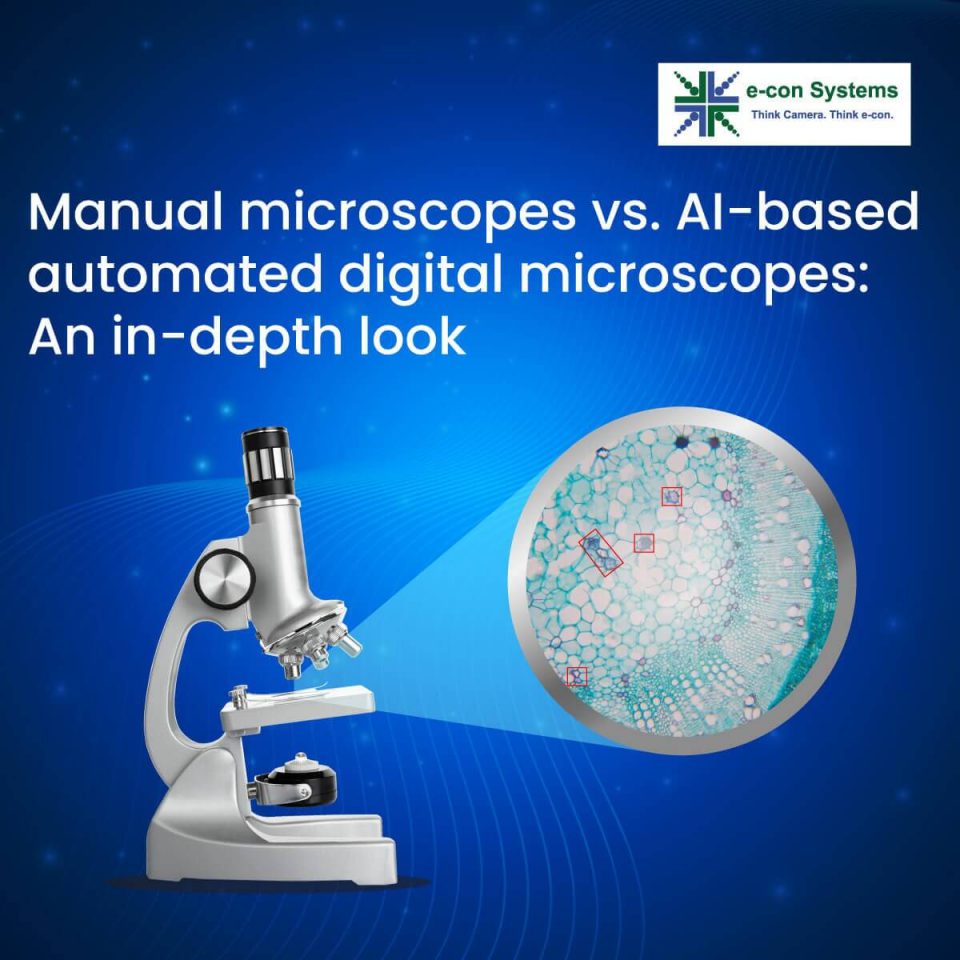Microscopy has long been an essential tool in various medical and life science fields, enabling researchers, scientists, and others to study the intricate details of biological specimens and materials at the cellular and molecular levels. Traditionally, manual microscopy has been the gold standard, requiring skilled technicians to operate the instruments and analyze the resulting images. However, recent advancements in AI-based automated digital microscopy have revolutionized the field, enabling faster and more precise analysis of samples.
In this blog, let’s explore the advantages and disadvantages of manual and automated microscopy and examine how AI-based embedded vision technologies are changing the medical and life science industry.
How do manual microscopes work?
Manual microscopes use a series of lenses to magnify small objects, such as cells or microorganisms, so that they can be seen and studied in detail. These microscopes require careful adjustment and handling to produce clear images, and the observer must have a certain level of expertise in order to interpret the results accurately.
Role of cameras in manual microscopes
Cameras are typically attached to the eyepiece of the microscope and use a combination of lenses, sensors, and software to capture and process the image. The camera lens is positioned over the microscope eyepiece and focused on the image produced by the eyepiece lens. The camera sensor then captures the image and converts it into a digital format that can be stored or displayed.
Some cameras used in manual microscopes are equipped with additional features such as high-speed capture, automatic exposure adjustment, and image stacking. These help improve the quality of the images captured and reduce the time required.
How do AI-based automated digital microscopes work?
Automated digital microscopes integrate AI algorithms and advanced imaging systems to automate and enhance the process of microscopy. Such microscopes utilize high-resolution cameras, often combined with motorized stages, to capture images of specimens. The images are then processed and analyzed using AI algorithms to extract meaningful information.
The AI algorithms employed in these microscopes are trained on large datasets of annotated images, allowing them to recognize patterns, classify structures, and perform complex image analysis tasks. In addition, the algorithms continuously improve their accuracy and adaptability through machine learning techniques, enabling them to handle a wide range of specimens and research applications.
This automation speeds up the analysis process and enhances the objectivity and reproducibility of results. Hence, AI-based automated digital microscopes have the potential to revolutionize scientific research and medical diagnostics.
Role of cameras in AI-based automated digital microscopes
Cameras play a pivotal role in capturing high-quality images of specimens for subsequent analysis and processing by AI algorithms. This is because they leverage imaging technologies, such as CMOS or CCD sensors, which convert light into electrical signals. When light enters the microscope and interacts with the specimen, it is focused onto the camera sensor through a series of lenses. The sensor then converts the light signals into digital data, creating a digital image of the specimen.
This digital image contains a grid of pixels, each pixel’s value representing the intensity or color information at a particular location. These images can be captured in real-time, allowing for continuous observation and analysis of the specimen. The captured images are subsequently fed into AI algorithms for automated analysis and interpretation.
Manual microscopes vs. AI-based automated digital microscopes
As you may have observed, manual microscopy and AI-based automated digital microscopy are two approaches with distinct advantages and considerations. Let’s see a side-by-side comparison:
|
MANUAL MICROSCOPES
|
AI-BASED AUTOMATED DIGITAL MICROSCOPES
|
|
|
Efficiency
|
While there’s flexibility and control, human error and variability also exist. Plus, manual analysis can be time-consuming, especially when examining large datasets or searching for rare features.
|
ML algorithms are used to analyze images automatically and provide consistent results. So, vast amounts of data can be processed quickly to identify features with high precision and enable accurate analysis.
|
|
Expertise and Training
|
Skilled technicians or researchers – proficient in microscopy techniques and image interpretation – are required for manual microscopy. Extensive training may also be necessary to identify subtle features or anomalies.
|
AI-based systems reduce the dependency on manual expertise as the system can autonomously analyze images, minimizing the need for specialized training. This makes the technology accessible to a broader range of users.
|
|
Flexibility
|
Various imaging techniques can be used as operators can adjust parameters, change objectives, and manually explore different regions of interest.
|
There may be limitations in adapting to unconventional sample types or experimental conditions.
|
|
Standardization and Reproducibility
|
Human operators may introduce variability in image acquisition and interpretation, which can affect the consistency and reliability of results.
|
AI algorithms can analyze images based on predefined criteria and standardized protocols, ensuring consistent and reproducible analysis across different samples and users.
|
In conclusion, choosing between the two types of microscopes depends on the specific research needs, the complexity of the samples, and the desired level of automation and accuracy. However, it is becoming increasingly clear that AI-based automated digital microscopes represent where the industry is – and where it is heading.
Cameras by e-con Systems for AI-based automated digital microscopes
e-con Systems, with close to two decades of experience, has been designing custom cameras for medical and life science applications. Recently, we have successfully launched the See3CAM_5OCUG – a 5MP Sony® Pregius IMX264 Global Shutter Color Camera. It is perfect for applications such as digital microscopes, fluorescence imaging, live cell imaging, point-of-care diagnostic devices, ophthalmic devices, and molecular imaging. This high-sensitive color camera leverages the Sony Pregius IMX264 CMOS sensor and comes with features like:
- Global shutter technology
- High dynamic range
- High frame rate
- IR sensitivity
- C-mount lens holder
- High SNR
Please visit our Camera Selector page to see our entire portfolio of cameras. If you require any help with integrating camera solutions into your vision-based application, please write to camerasolutions@e-consystems.com.

Balaji is a camera expert with 18+ years of experience in embedded product design, camera solutions, and product development. In e-con Systems, he has built numerous camera solutions in the field of ophthalmology, laboratory equipment, dentistry, assistive technology, dermatology, and more. He has played an integral part in helping many customers build their products by integrating the right vision technology into them.




